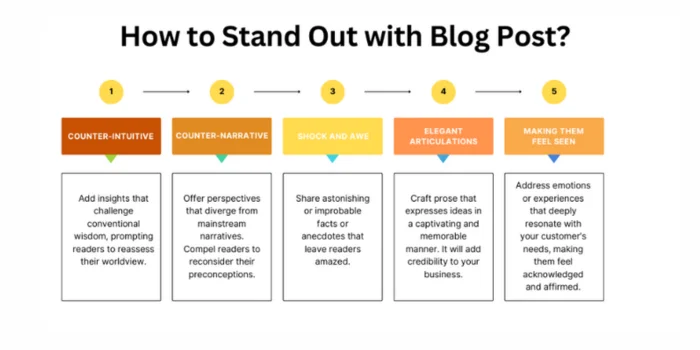

Blogs are a great medium to connect with clients and customers, bringing the utmost effectiveness in marketing products and services. Beyond mere promotion, they offer a platform for dispensing invaluable insights and information, positioning your business as a thought leader within your industry.
You can engage your audience through blogging, nurturing trust and credibility. Each blog post becomes an opportunity to offer insights into topics of relevance, uncovering nuances and trends that elevate your brand above the competition.
Read on to learn more about writing effective blogs for your business.
Start your blogging journey by selecting a topic that ignites your passion and aligns with your business expertise. Before diving into writing, choose a broad subject area that resonates with your business goals and strategies.
For instance, if your company offers business management solutions, consider discussing the benefits of using integrated software to streamline operations across marketing, sales, and service teams.
For instance, if you're running a food business, you can consider the following topics to write a blog post:
|
Recipe Showcase: Deliciously Simple: 5-Minute Avocado Toast Recipe Ingredient Spotlight: The Power of Quinoa: Why You Should Add This Superfood to Your Meals Behind-the-Scenes: A Day in the Life of a Local Artisan Baker: Crafting Handmade Sourdough Health and Wellness Tips: Fueling Your Body Right: Top 10 Healthy Snacks for On-the-Go Lifestyles Community Engagement: Building Connections: Hosting a Charity Bake Sale for Local Causes |
2. Know Your Competition
Examining the tactics of your well-established competitors can help you create a successful blog. You can learn a lot that will benefit your development. It’s crucial to remember that the goal is to learn more about what makes a high-quality blog engage with readers rather than trying to copy their every action.
Here's how to evaluate the blogs of your rivals successfully:
If you wish to create a successful blog post, yours must stand out from the thousands of other posts on the internet daily. Making an impression is crucial to drawing in and keeping readers. The most important element needed to accomplish this is novelty.
Julian Shapiro distinguishes five categories of innovation:

a. Counter-Intuitive
Add insights that challenge conventional wisdom, prompting readers to reassess their worldview.
b. Counter-narrative
Offer perspectives that diverge from mainstream narratives. Compel readers to reconsider their preconceptions.
c. Shock and Awe
Share astonishing or improbable facts or anecdotes that leave readers amazed.
d. Elegant Articulations
Craft prose that expresses ideas in a captivating and memorable manner. It will add credibility to your business.
e. Making Them Feel Seen
Address emotions or experiences that deeply resonate with your customer’s needs, making them feel acknowledged and affirmed.

To create content that connects with and benefits your customers, you must comprehend their problem concerns. You can implement the following tips:
Tip 1: Conduct in-depth market research to determine the reoccurring difficulties and barriers that customers experience.
Tip 2: Actively listen to consumer input and interact with key stakeholders.
Tip 3: Create content tailored to these particular demands, providing useful tips, industry insights, and guidance to establish your brand as a reliable resource.
Tip 4: To gain your audience’s trust and authenticity, use case studies, success stories, and open communication.
Tip 5: To improve and fine-tune your content strategy over time, analyze the impact of your activities, solicit feedback, and ultimately drive business results while cultivating enduring connections with clients or customers.
Gain a deep understanding of your customer demographics, including age, gender, interests, and buying behaviors. Tailor your content to resonate with their preferences and lifestyles.
When writing a blog, it's important to highlight the qualities of your products or services and how they directly improve the lives of your clients and customers. Emphasizing distinctive aspects should always be connected to the primary value proposition.
Ask Yourself
Clients and customers respond well to benefits that are framed in terms of concrete ways that they can improve their quality of life, whether it’s a feature that saves time and simplifies tasks, a quality improvement that guarantees longevity and durability, or a functionality that infuses their lifestyle with a hint of luxury.
Writing a blog is more than simply information sharing. You need to position your business as a thought leader in your field. You can offer insightful commentary and engage your audience by demonstrating expertise.
Tricks to Help You:By continuously producing excellent content highlighting your experience, you can establish your business as a reliable source of insightful information for people in your sector.
Speaking to clients and customers requires you to keep your voice professional and use language appropriate to your field.
Do's and Don'tsYou can effectively engage your clients and customers and establish trust by speaking professionally yet approachable. This will ultimately lead to meaningful connections and commercial prospects.
Since your customers will frequently see your blog post title first, it must catch their eye and succinctly convey the topic or value of reading the piece. If you wish to increase discoverability, make your post interesting, descriptive, and search engine optimized.
The tone of the entire blog article is established in the introduction. It should pose a question, address an issue, provide an interesting story, or provide startling information to pique the reader's curiosity. Readers should be motivated to read the remainder of the content by the introduction.
The blog post's body should offer insightful analysis, useful information, or answers to the customer's questions or issues. It should be accurate, thoroughly researched, and presented in an understandable, structured way. Utilize case studies, figures, expert quotes, and examples to bolster your arguments and give your writing more authority.
It is simpler to read and browse a well-structured blog post. Make the content easier to read using bullet points, subheadings, and headings. This makes the text easier to read and helps customers find the information they need more quickly.
The tone of your writing should be right for both the blog post's subject matter and its target audience. Try to have a conversational tone that sounds genuine and approachable. Ensure you avoid using extremely formal or technical language, which can turn off readers.
Adding pictures, infographics, or videos to a post can improve the target audience's comprehension of the information and give it a more eye-catching appearance. Strategically use images to highlight important ideas, break up text-heavy passages, and keep readers interested.
Every blog should have an engaging CTA to encourage readers to take the next step. This may be becoming a follower on social media, downloading a free resource, joining a webinar, or buying your product. Ensure that the call to action (CTA) adds value to the reader and is pertinent to the post's content.
Ensure your blog post is optimized for relevant keywords your customers will likely look for. This will increase its exposure in search results. Include these keywords organically in the post's title, headings, body, and meta description. Provide more context and credibility by including both internal and external connections.
(Read about how Lexiconn helped Amazon India to grow B2B traffic.)
You can make your blog article more relatable and interesting by adding personal stories, experiences, or opinions. It gives your material more authenticity and facilitates a more human connection with customers.
Your blog post's conclusion should summarize the key ideas and takeaways covered throughout the piece. In addition, it needs to restate the topic's significance and offer a feeling of resolution. This section can be used to promote more conversation, solicit feedback from readers, and Call to Action.
Using the power of blogging is not an option but a strategic imperative for your businesses to thrive in today's competitive world. As you embark on your blogging journey, remember that every post is an opportunity to engage, educate, and inspire. So, start crafting blogs that leave a lasting impact. Ready to take your business to the next level?
Visit us at www.lexiconn.in and witness firsthand the power of leveraging blogs to connect with your audience. With a rich legacy of over 14 years in content creation and blog writing, we stand to help your business through compelling storytelling and strategic communication. Let us guide you on a journey where each blog post becomes a way for deeper engagement, enhanced brand visibility, and lasting customer relationships. LexiConn also offers a free 30-minute content consultation session to help you with your content strategy. Experience the difference today with LexiConn.



I have read and accept the Privacy Policy
Read More